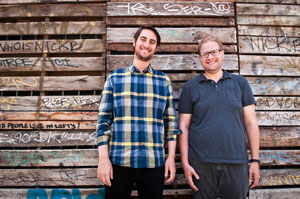
In a scene from Paramount Pictures’ “The Dictator,” Sacha Baron Cohen’s character sits down at a restaurant in New York to talk to a man he presumed he had executed.
Though the scene was indeed shot in New York, Baron Cohen did some of his funniest takes in front of a green screen in Los Angeles. So, with some magic by downtown L.A.’s Level 256 Visual Effects, the scenes were grafted together to make them appear seamlessly shot on location.
Comedies might not seem to benefit from the wizardry of modern-day special effects, but many have hundreds of effects in them. Since movies in that genre are under constant revision as test audiences give feedback, new jokes and shots are constantly added, creating work as sophisticated as inserting characters into a finished scene or as simple as removing unsightly wires and camera rigs from the background.
“It allows the comedians to experiment and to make the funniest thing they can,” said Scott Davids, founder of Level 256. “We can help glue things together that might not have gone together.”
The effects aren’t as high priced as creating aliens with computer graphics, but studios will often set aside hundreds of thousands of dollars for comedy effects work.
While it would seem that all the work from studios might go to acclaimed effects houses such as San Francisco’s Industrial Light & Magic – the brains behind effects-laden hits from the “Star Wars” series to “The Avengers” – that’s not so. Since those brand-name firms have significant overhead and staffs of hundreds, nimbler effects houses such as Level 256, which has a core staff of a half-dozen and brings in temps for big projects, are popping up to respond quickly and more cheaply to smaller jobs.
“A lot of the big companies are losing this kind of work. That creates an opportunity for these companies,” said Chris Cram, vice president of visual effects at Universal Pictures, which distributed the 2011 hit “Bridesmaids,” as well as other pictures on which Level 256 worked.
Recurring roles
Davids, a 31-year-old L.A. native, scored some of his first studio gigs as a film editor, where he helped splice and stitch together scenes in comedies such as Baron Cohen’s “Borat” and Judd Apatow’s “Knocked Up.”
He got a taste of effects work when he began fooling around with software to make quick fixes such as removing sound booms from sight, finding that he could often make the fixes faster than the large effects companies hired to do the job.
Soon after those movies, Davids launched a two-man effects boutique with a friend, which he left in 2009 to start Level 256, an homage to old arcade games, which had 256K random-access memory.
Startup costs for Level 256 were limited to the price of rent in the Downtown Arts District, since Davids already owned the software and computer to do the work. For early gigs, he found his experience in the movie editing room came in handy.
“Originally, a lot of the work I was able to get came through editors,” he said.
As more jobs came in, Davids was able to bring in longtime friend Seth Kleinberg as head of production, as well as a handful of others.
In addition to recurring work on movies created by and starring Baron Cohen, the firm’s work also is prominent in movies produced by Apatow, including “Bridesmaids.” In a now-infamous scene, the bridesmaids are observed getting ill in a bathroom from a bird’s-eye view. Though it’s set up to look like a single, simultaneous take, Level 256 actually combined separate split-screen takes to get all of the actresses’ best performances on screen at the same time.
Over on the Miracle Mile, Dick Edwards runs one-man effects firm Invisible Effects. He has done wire removals and other “invisible” effects for many Ridley Scott movies, such as recently released “Prometheus.” But he also has worked on comedies such as Warner Bros.’ “Hangover 2.”
He said one reason he likes the niche is that big-budget effects are subject to a highly competitive bidding process. With comedies and invisible effects, directors and editors will often return to a preferred company without shopping the job around.
“They hand the work to people they can trust,” he said.
Staying small
Level 256’s success has allowed it to expand into the invisible effect work on big-budget action movies such as Universal’s recent “Battleship” and the forthcoming “Bourne Identity.”
But as the firm gets more work and is asked to do more complex effects, a big concern going forward will be managing costs, said Bob Coleman, president of Digital Artists Agency, an L.A. visual effects talent agency.
He noted that other firms that have started small have famously imploded when they got too big, such as CafeFX in Santa Maria, which went out of business in 2010. CafeFX started out on low-budget commercials in the early 1990s but quickly grew to create complex computer graphics for feature films. Ultimately, the costs of expansion became too burdensome for the company to remain competitive with its pricing.
“If you operate lightweight you can definitely make a profit,” Coleman said.
